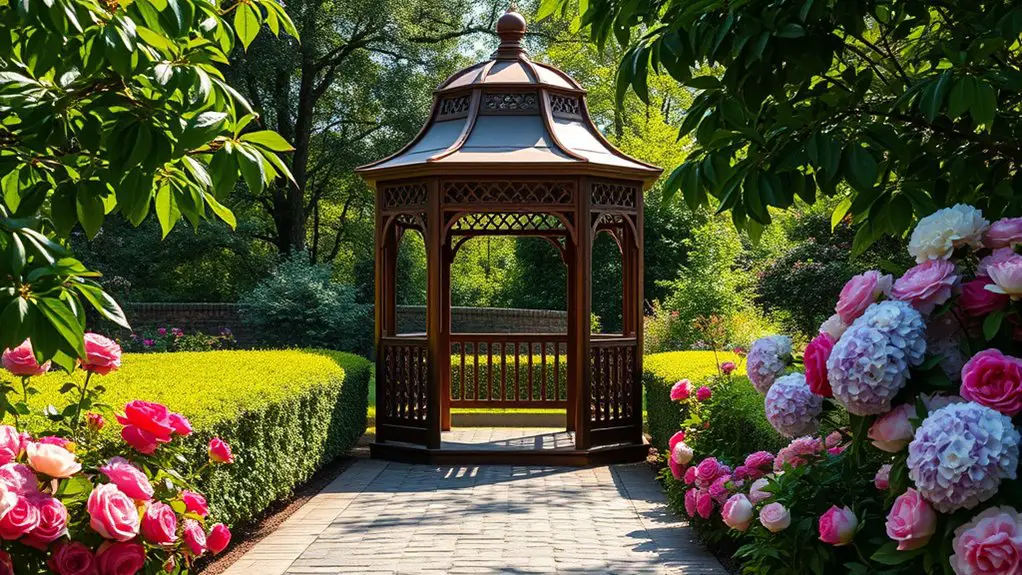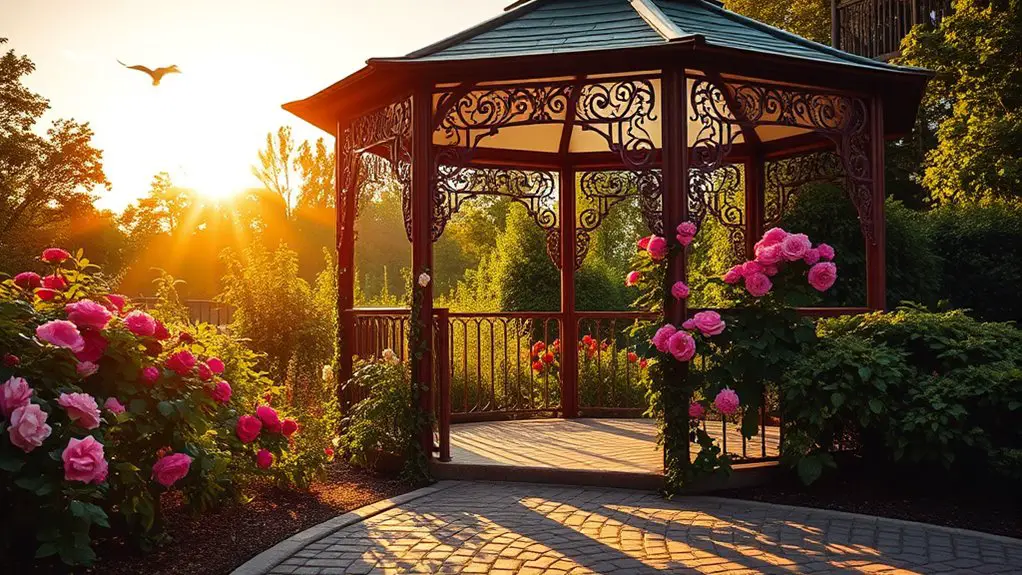Victorian gardens are known for their elegance, and gazebos are central to that beauty. These structures, emerging during the Victorian era, symbolize leisure and sophistication, often adorned with intricate designs like pointed arches and latticework. They served as social spaces for gatherings, tea parties, and dances, fostering community connection. Gazebos also reflect the era’s romantic ideals by blending nature with artistry. To uncover more about their enduring influence, you might explore how these designs shape today’s landscapes.
The Origins of Gazebos: A Victorian Perspective

Although gazebos have roots that stretch back to ancient civilizations, their modern incarnation emerged during the Victorian era, where they became symbols of leisure and sophistication in the burgeoning middle class. In this time, you’d find gazebos adorned with intricate designs, reflecting the Victorian aesthetics that favored ornamental structures. These garden retreats weren’t just functional; they offered a space for social gatherings, relaxation, and enjoyment of nature, embodying an ideal of freedom that resonated with the era’s aspirations.
Constructed with wrought iron or painted wood, they often featured elaborate latticework, allowing for climbing plants to intertwine and create a lush canopy. You could see how these gazebos became focal points in gardens, inviting you to pause and appreciate beauty. Their design elements—such as spindled railings and decorative finials—invited a sense of whimsy and elegance, making them indispensable to the Victorian garden landscape. Moreover, the evolution of gazebos from ancient civilizations to Victorian aesthetics illustrates their enduring significance in garden architecture.
Architectural Styles and Innovations
As you explore the architectural styles and innovations of gazebos, it becomes clear that these structures evolved beyond mere decorative elements into expressions of artistic creativity and engineering ingenuity. The Victorian era saw a flourish of architectural styles, particularly the Gothic Revival, which infused gazebos with intricate ornamental details that mesmerized and enthralled.
Here are three key innovations that defined this period:
- Pointed Arches: Emulating cathedrals, these arches added drama and height, enhancing the visual appeal.
- Lattice Work: This technique introduced airy structures that danced with light, creating enchanting shadows.
- Elaborate Rooflines: Unique shapes and angles not only showcased craftsmanship but also invited playful exploration.
Additionally, these gazebos often featured elaborate rooflines, which not only showcased craftsmanship but also invited playful exploration. These innovations transformed gazebos into enchanting retreats, merging functionality with aesthetic wonder, allowing for personal reflection and appreciation of nature’s beauty.
Gazebos as Social Spaces

Gazebos have long served as essential social spaces, providing a unique blend of comfort and connection for communities. These structures became the heart of social gatherings, where friends and family could come together, share stories, and enjoy each other’s company. Picture yourself lounging in a beautifully designed gazebo, surrounded by lush gardens, as laughter fills the air.
During the Victorian era, these spaces flourished, becoming venues for leisure activities such as tea parties, musical performances, and even dances. The open layout encouraged interaction, allowing you to both connect with your companions and appreciate the surrounding beauty. Gazebos often served as focal points in outdoor spaces, enhancing the overall aesthetic and inviting further social engagement.
As you step into a gazebo today, you can still feel its historical significance—a comforting reminder of the past. It invites you to embrace leisure, offering a tranquil escape from daily life while fostering meaningful connections. Gazebos truly embody the spirit of community and the joy found in simple, shared moments.
The Role of Nature in Victorian Garden Design
Victorian gardens were designed to be a harmonious blend of nature and artistry, reflecting the era’s romantic ideals and appreciation for the outdoors. These gardens weren’t just spaces to admire; they embodied deeper meanings through their design. Here are three key aspects of their natural aesthetics:
Victorian gardens artfully meld nature and creativity, embodying romantic ideals and inviting deeper emotional connections through their intricate designs.
- Floral Variety: A diverse array of flowers was used, symbolizing different emotions and ideas, making the garden a living tapestry of human experience.
- Pathways and Layouts: Curved pathways invited exploration, encouraging visitors to lose themselves in nature’s beauty, fostering a sense of freedom and discovery.
- Water Features: Ponds and fountains added tranquility and reflected the sky, enhancing the garden’s symbolism of life and renewal.
In this way, Victorian gardens blended beauty with meaning, allowing you to connect with nature while appreciating the artistry of design, ultimately creating a sanctuary for reflection and joy.
The Legacy of Victorian Gazebos in Modern Landscapes

The Legacy of Victorian Gazebos in Modern Landscapes
While the charm of gazebos may seem like a relic of the past, their influence on contemporary landscape design remains undeniably profound. You’ll notice modern adaptations of these structures in parks and private gardens, where they serve as focal points that invite relaxation and social interaction. Their elegant forms and open designs echo Victorian aesthetics, yet they’re often crafted from sustainable materials, reflecting today’s eco-conscious values. Additionally, the installation of gazebos can significantly increase property value, making them an attractive feature for homeowners.
The cultural significance of gazebos persists, symbolizing a desire for connection with nature and community. In your own outdoor space, you can find that a well-placed gazebo enhances not just the visual appeal but also the emotional atmosphere, encouraging gatherings and quiet contemplation alike. By embracing the legacy of Victorian gazebos, you’re not just honoring history; you’re actively participating in a timeless tradition that celebrates freedom, creativity, and the simple joys of life outdoors.
Frequently Asked Questions
What Materials Were Commonly Used to Build Victorian Gazebos?
When you envision a Victorian gazebo, think of wooden structures adorned with ornamental details. These materials create a sanctuary, inviting you to escape and find solace, while reflecting the era’s love for intricate craftsmanship and natural beauty.
How Did Weather Affect Gazebo Design in Victorian Gardens?
Weather patterns greatly influenced gazebo design adaptations. You’ll notice how architects incorporated sturdier materials and sloped roofs to withstand rain and snow, ensuring these structures remained inviting retreats, even amidst nature’s unpredictable whims.
Were Gazebos Used in Urban Settings During the Victorian Era?
Imagine strolling through urban elegance, where gazebos adorned civic spaces. They weren’t just ornamental; they served as social hubs, inviting community gatherings and fostering connections amidst the bustling city, creating pockets of tranquility and beauty.
What Were Typical Features of Victorian Gazebo Interiors?
Victorian gazebo interiors featured ornate furnishings and intricate decorative motifs, creating an enchanting atmosphere. You’d find plush seating, vibrant textiles, and ornamental details, all designed to invite relaxation and inspire conversations amidst nature’s beauty.
How Did Social Class Influence Gazebo Ownership in Victorian Times?
In Victorian society, class distinctions shaped gazebo accessibility. The wealthy adorned gardens with elaborate structures, symbolizing status, while the lower classes admired from afar, creating a stark contrast that reflected societal boundaries and aspirations for freedom.

